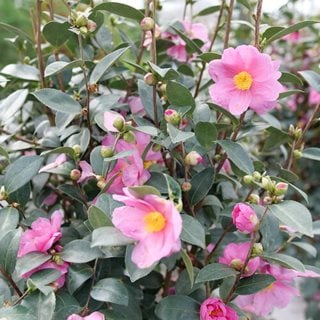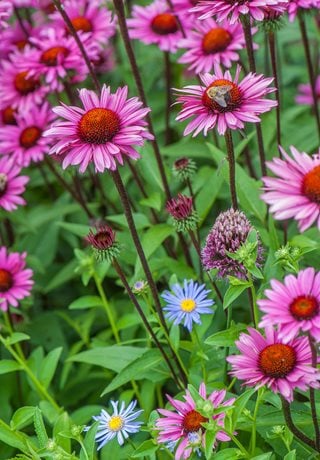Growing Camellias in Your Garden
Camellia flowers are the dependable stars of mild gardens in winter and early springCamellias have been prized possessions of gardeners for decades. They thrive in mild climates from California to Florida and are available in thousands of cultivars. These broadleaved evergreen shrubs have durable, glossy foliage and gorgeous flowers. The most common species of camellias are Camellia japonica and Camellia sasanqua.
On this page: The Basics | Planting | Care | Pictures | Design Ideas | FAQs
On this page:
BASICS
Zones:
7-10, for most varieties
Height/Spread:
Most shrubs reach a height between 6 and 12 feet, and just about as wide.
Exposure:
Partial shade to full shade. Most prefer dappled light, but a few varieties need (or tolerate) more sun than others. In general, red-flowered varieties can withstand more sun than white varieties.
Bloom time:
Different varieties of camellias bloom from late fall to mid-spring:
- C. sasanqua tends to bloom earlier, mid-fall to early winter
- C. japonica blooms from mid-winter to spring
- Hybrid bloom times will vary depending on variety
Stagger plantings of early, mid- and late varieties and you can have flowers from November through April or May.
Flower color and characteristics:
Beautiful flowers, mainly white and shades of pink or red, and various combinations. They come in various shapes: anemone, single, semi-double, formal double, rose-form, double, and peony form.
Life span:
Camellias are long-lived plants, with some living more than 100 years.
PLANTING CAMELLIAS
"Camellias like to be mounded up a little bit when you plant them—they don't particularly like wet feet." — " Jim Putnam, Hortube Youtube channel.
When to plant:
In zones 8-10, camellias can be planted in the fall, winter or spring. However, in zone 6 or 7, they are better planted in spring to allow their roots time to establish before colder weather sets in.
Where to plant:
Site in a location protected from wind. In hot climates, locate where they are protected from bright light or leaves may be scalded by the sun.
How to plant:
Dig a hole as deep as the rootball and twice as wide. Position the camellia so that the top of the rootball sits 2 to 4 inches above the surrounding soil—this helps prevent water from pooling around the trunk. Backfill with soil, sloping it gently up to the edges of the rootball. Avoid covering the top of the rootball with soil. Instead, mulch around the base, keeping mulch at least an inch away from the stem and no more than 1 inch deep on top of the rootball. Water thoroughly.
Planting in containers:
Camellias are great for well-draining containers and should be planted with potting mix containing 50 percent or more organic material. Choose smaller, slower-growing varieties. Learn more in a short video, Growing Camellias in Containers, from the Royal Horticultural Society.
CAMELLIA CARE
Soil:
Should be well-drained with a pH of 6 to 6.5 (slightly acid). Keep it moist.
Amendments:
Keep roots cool with a 2-inch layer of mulch such as pine straw or ground bark. Avoid “mulch volcanoes”; as Celeste Richard, executive director of the American Camellia Society, says, “mulch out, not up.” Feed with one of many available camellia fertilizers or a general 10-10-10 fertilizer in spring after the flowers have dropped. Avoid feeding camellias after July, as late feeding can cause bud drop.
Water:
Water regularly for the first couple of years, then keep soil moist, but not too wet. Provide summer water in dry climates. "Keep well-watered through the summer—this is when the plants produce next year's flower buds." — How to Grow Camellias, Royal Horticultural Society.
Pruning:
Pruning is rarely needed, but it helps to remove crossover limbs or diseased/dead wood. This can be done after blooming has finished in spring.
Diseases/Pests:
For pests, natural products are available, such as neem oil. Camellia petal blight affects flowers and buds, turning them an unsightly brown. This is best avoided by removing spent flowers and not letting old flowers linger on the soil surface. Dispose of flowers in garbage; do not compost, as composting will likely spread the fungal spores.
"Symptoms of petal blight can be confused with cold injury, water spots, or Botrytis infections. In the case of petal blight, not all blossoms are affected, and the distribution of affected blossoms often appears to be random." — American Phytopathological Society, Plant Disease Notes
CAMELLIA PICTURES
In his book, Plant This Instead!, Troy B. Marden recommends the following cold-hardy varieties, which can be grown in zone 6:
- ‘April Remembered’
- ‘April Blush’
- ‘April Snow’
- ‘April Kiss’
- ‘April Rose’
- ‘Korean Fire’
DESIGN IDEAS
Camellias are versatile in the landscape—use as single specimen plants or informal screen, and they are great in containers. Robert Bowden, director of Leu Gardens in Orlando, Florida, home to one of America’s largest collections, offers these tips:
- Please don’t plant them too close together! Let them stand on their own. They are elegant, regal plants and deserve lots of space: a minimum of 15 feet all round.
- Snip off as many blooms as you like to use indoors. Cut flowers in the early morning shortly after they open, and float them in a bowl of water placed on a low table. For interior floral design inspiration, see more here.
- Buy one with the shape you like—upright, oval, round—and plant it in a location where you don’t have to prune.
Tom Johnson, executive director of Magnolia Plantation and Gardens in Charleston, South Carolina, adds:
- Give them room to grow. While a few varieties are shorter and most are slow growing, “camellias are trees.” The collection at Magnolia includes specimens 10 to 30 feet tall, some with 8-inch trunks.
FREQUENTLY ASKED QUESTIONS
Are camellias deer resistant?
Mature plants are not usually on the preferred menu of deer, although sometimes young plants will suffer damage. For this reason, you may wish to protect your newly planted camellias with some type of barrier. Keep in mind that no plant is completely safe from harm if other food sources are not available. Additionally, deer in some regions may graze on them, while in other regions they will leave them untouched. Learn more about deer-resistant plants.
Are camellias poisonous?
They are not poisonous, making them safe garden plants for your children and pets. In fact, the leaves of Camellia sinensis are used to make tea. However, if eaten in large quantities, the plant’s caffeine content could cause problems such as elevated heart rate. For more safe plant choices, see 20 Common Plants Safe for Cats & Dogs.
Are camellias fast growing?
Generally, they grow at a medium pace for an evergreen plant, with most putting on about 4 to 8 inches a year. If your heart is set on one, select a sasanqua which will grow faster than a japonica. ‘Kanjiro’ may be a good cultivar to try—a gardener in Atlanta reported hers putting on more than 4 feet in just three years (an average of 16 inches a year). Keep in mind that growth rate varies wildly depending on zone, exposure, soil, and other conditions. If you need something that matures at a faster rate you should consider fast-growing deciduous plants for filtered light such as sweetshrub (Calycanthus), hydrangeas, spireas, elderberry, forsythia. Evergreen alternatives include heavenly bamboo, osmanthus, cherry laurel, and Solanum rantonnetii.
Are camellias fragrant?
Only a few are scented—consider one of these varieties if locating near a door or window: ‘High Fragrance’, ‘Cinnamon Cindy’, or ‘Kramer’s Supreme’.
Why is my camellia not flowering?
Make sure it's getting enough water in summer and regular water year-round in order to produce healthy buds. Mulch will help maintain soil moisture. Late (after July) or excessive fertilizer can also cause bud drop.
Resources:
- Camellias: The Complete Guide to Cultivation and Use by Jennifer Trehane.
- The Illustrated Encyclopedia of Camellias by Stirling MacOboy.
- Check out the American Camellia Society website.
- For more information or to plan a visit to Harry P. Leu Gardens in Orlando, FL, see www.leugardens.org.
RELATED:
Shrubs for Shade
16 Winter Flowers for Your Garden
Grow Your Own Rhododendrons










